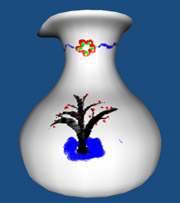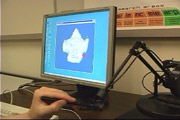


Haptic Sculpting and Painting
A haptic display device is a force output device as well as a point input device in 3-D space. It renders the virtual object tangible and provides an intuitive interface with a virtual environment. When the user touches a virtual object, the haptic rendering algorithm generates an adequate force field to simulate the presence of the object and surface properties such as friction and texture.
Haptic decoration allows the user to paint directly on the surface (haptic painting) and then feels the paint thickness variation due to the painted image. In haptic painting, a volume fill algorithm based on a volumetric representation is used to find the 3D triangles to be rasterized within the 3D brush volume. Our image-based haptic texturing is implemented by modulating potential values in the volumetric implicit surface representation resulting in a new geometry of the implicit surface. By simulating the textured implicit surface rather than a geometric model, the user correctly senses the textured surface regardless of the texture mapping method and the complexity of the geometric model.
More Info
White Paper ("An Implicit-Based Haptic Rendering Technique")
White Paper ("Haptic Editing of Decoration and Material Properties")
Laboratory